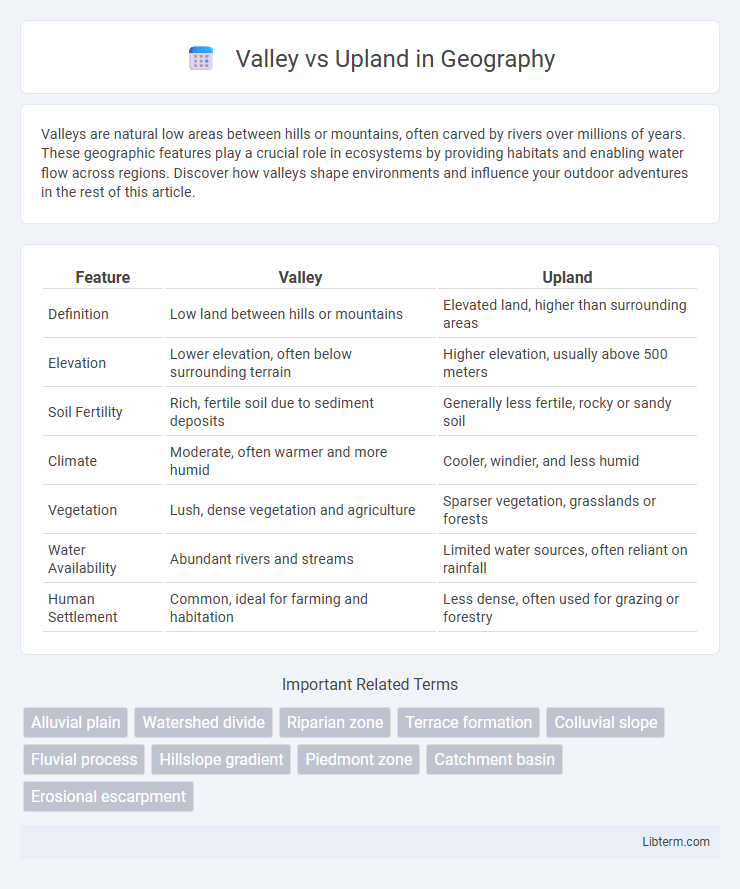Valleys are natural low areas between hills or mountains, often carved by rivers over millions of years. These geographic features play a crucial role in ecosystems by providing habitats and enabling water flow across regions. Discover how valleys shape environments and influence your outdoor adventures in the rest of this article.
Table of Comparison
| Feature | Valley | Upland |
|---|---|---|
| Definition | Low land between hills or mountains | Elevated land, higher than surrounding areas |
| Elevation | Lower elevation, often below surrounding terrain | Higher elevation, usually above 500 meters |
| Soil Fertility | Rich, fertile soil due to sediment deposits | Generally less fertile, rocky or sandy soil |
| Climate | Moderate, often warmer and more humid | Cooler, windier, and less humid |
| Vegetation | Lush, dense vegetation and agriculture | Sparser vegetation, grasslands or forests |
| Water Availability | Abundant rivers and streams | Limited water sources, often reliant on rainfall |
| Human Settlement | Common, ideal for farming and habitation | Less dense, often used for grazing or forestry |
Introduction: Understanding Valleys and Uplands
Valleys are low-lying areas usually located between hills or mountains, often shaped by rivers and glacial activity, creating fertile soil and unique ecosystems. Uplands refer to elevated regions such as plateaus or highlands, characterized by higher altitudes, rugged terrain, and distinct climatic conditions compared to surrounding lowlands. Understanding the geological formation and ecological significance of valleys and uplands is crucial for land management, agriculture, and biodiversity conservation.
Geographic Definitions: Valley vs Upland
Valleys are low-lying areas of land typically found between hills or mountains, formed by river erosion or glacial activity, characterized by gentle slopes and fertile soil ideal for agriculture. Uplands refer to higher elevation regions, often consisting of plateaus or hilly terrain with well-drained soils and sparse vegetation, positioned above valleys and plains. These geographic definitions highlight distinct landforms impacting climate, vegetation, and human settlement patterns.
Formation Processes of Valleys and Uplands
Valleys primarily form through erosion by rivers and glaciers, where persistent water or ice movement carves out lower land areas between hills or mountains. Uplands develop from tectonic uplift, volcanic activity, or the gradual accumulation of sedimentary deposits, resulting in elevated landforms above the surrounding terrain. Differential weathering and erosion further shape both valleys and uplands, influencing their distinct topographical features.
Key Physical Characteristics
Valleys are low-lying areas between hills or mountains characterized by flat or gently sloping terrain and often contain rivers or streams. Uplands are elevated regions with hilly or plateau-like features, generally higher in altitude with more rugged terrain and less dense vegetation than valleys. The distinct elevation difference impacts climate, soil composition, and biodiversity, with valleys typically having richer soils and more diverse ecosystems due to water availability.
Climatic Differences Between Valleys and Uplands
Valleys typically experience warmer temperatures and higher humidity levels due to their lower elevation and trapped air, which can lead to more stable microclimates suitable for diverse vegetation. Uplands, characterized by higher altitudes, often have cooler temperatures, increased wind exposure, and lower atmospheric pressure, contributing to a harsher climate with greater temperature fluctuations. These climatic differences significantly affect local weather patterns, biodiversity, and agricultural practices in valley and upland regions.
Soil Composition and Fertility
Valley soils typically consist of rich alluvial deposits with high organic matter and nutrient content, resulting in greater fertility compared to upland soils. In contrast, upland soils are often sandy or rocky with lower moisture retention and nutrient levels due to increased erosion and leaching. This significant difference in soil composition affects agricultural productivity, making valleys prime locations for intensive farming.
Biodiversity and Ecosystem Diversity
Valleys typically exhibit higher biodiversity due to varied microclimates and moisture levels supporting diverse plant and animal species, while uplands often host specialized ecosystems adapted to drier, windier conditions. Ecosystem diversity in valleys includes wetlands, riparian zones, and forested areas, contrasting with upland ecosystems dominated by grasslands, heathlands, or coniferous forests. These differences create distinct ecological niches critical for maintaining landscape-scale biodiversity and ecosystem services.
Human Settlements and Land Use
Valley regions often support dense human settlements due to fertile soil and access to water resources, making them ideal for agriculture and urban development. Uplands typically experience lower population density but are utilized for grazing, forestry, and mining, reflecting the terrain's limitations and resource availability. Land use in valleys prioritizes crop cultivation and infrastructure, while uplands emphasize conservation and resource extraction.
Economic Activities in Valleys vs Uplands
Valleys typically support intensive agricultural activities due to fertile soils and access to water sources, enabling crop farming and livestock grazing to thrive. Uplands are often characterized by forestry, grazing of hardy livestock, and mining activities, capitalizing on mineral deposits and less arable land. Economic activities in valleys benefit from better transportation networks and market accessibility, whereas uplands rely more on natural resource extraction and niche agricultural products.
Environmental Challenges and Conservation Efforts
Valley ecosystems face increased risks of flooding, soil erosion, and habitat fragmentation due to agricultural runoff and urban development, leading to biodiversity loss and water quality issues. Upland regions experience challenges such as deforestation, soil degradation, and climate change impacts that threaten endemic species and reduce carbon sequestration capacity. Conservation efforts emphasize reforestation, sustainable land management, and the establishment of protected areas to preserve ecological balance and enhance resilience in both valley and upland environments.
Valley Infographic

 libterm.com
libterm.com